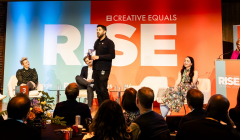
Are we leaving men and boys behind?
At Creative Equal’s RISE event, industry leaders consider how to reframe boys and men in marketing

If collaboration is the future of creativity, then does the future demand a more fluid approach to the ownership of creative ideas?

The fact that very few brands end up using the ideas their agencies pitch to them is perhaps the ultimate evidence of the extravagance of the pitch process. The time, effort and creative endeavour that doesn’t ever see the light of day.
Yet all too often those ideas do make it to their target audience; it is just that the agency initially pitching them receives no credit or payment. A perennial issue in marketing, the challenge of ownership of creative ideas hit the headlines earlier this year after BrewDog and its former agency Manifest clashed over the campaign to launch the drinks firm's alcohol-free beer Punk AF.
Whilst the scenario was not unique, the way in which it surfaced was unusual after Manifest founder Alex Myers turned to Twitter to declare the campaign was a Manifest concept, and one that the agency hadn’t been paid for. Imitation may be the sincerest form of flattery, but flattery does nothing for a business' bottom line in a challenging marketplace.
Cynics argue that there is no such thing as an original idea anymore, and there is no denying that marketers can often be pitched very similar ideas. Yet creativity is a craft and one that some believe demands both protecting and promoting. A model in which agencies routinely throw significant time and resources in pitching creative ideas without payment serves to dilute the value of those creative ideas in the first place.
In a media ecosystem that demands a greater degree of collaboration than ever, we asked some of the industry’s leading experts, who owns the creative idea?
We are all responsible for the idea. The strategy is the block of marble; the creative idea carves, buffs and polishes.
Jenna Russell

Having been a Creative and now a Creative Strategist, I can say, it's not as clear-cut as I once may have thought. Strategies are blocks of marble. We know its marble because the insights have identified that it is marble. But it has no shape, no life, no feeling and no character. What makes a great creative idea is how that block of cold, hard marble is transformed, crafted into shape with love and precision to become something robust but warm, evocative, and beautifully crafted.
As a Creative, the feeling was one of sole responsibility for the idea, which produced a mix of anxiety and fear that emanated from the blank page! And that assumes the brief’s proposition was clear and inspiring. Sitting on the side of strategic thinking I can now say that any good strategist will also have ideas after spending days immersing themselves to understand the audience, brand, competitive set, and sandwiching it all together with fascinating cultural insight.
The strategic value comes from dissecting all that thinking and learning time to find the initial spark. What can be shared with the creative team that excites them as much as I am in this very moment? Without them feeling like an idea has been handed to them, because it very much hasn't.
Ideas that are born out of genuine insight are still so hard to find. The creative team and their craft are reliant on a strategy that will lead them in a direction that's clear, stimulating and inspiring. From this foundation, creative people can imagine the biggest, wildest, thought-provoking or tear generating ideas that will be bang on brief.
Conclusion? We are all responsible for the idea. The strategy is the block of marble; the creative idea carves, buffs and polishes. We have all invested differing amounts of our vulnerable souls in helping give the resultant idea life.
The best ideas aren’t just own-able; they’re shareable. Easy to talk about, sell, a breeze to buy, fun to make and good enough to run for years.
Tristan Cavanagh

Creative people. After all, if you make something then you should at least take care of it. Whilst algorithms are trying to write our ads and we’re being bartered down to a line of added value in a global procurement spreadsheet, at least let us keep that.
The agency. Ideas don’t just come from creatives. A great strategic idea could be more valuable than umpteen non-grammatical end lines. Management consultants are poised to steal our lunch money, so let’s concentrate on what makes us special, and that’s still the idea.
Everyone. The best ideas aren’t just own-able; they’re shareable. Easy to talk about, sell, a breeze to buy, fun to make and good enough to run for years. That Meerkat. Talk to FRANK. ‘Good things come to those who wait’. Stoptober. Dumb Ways to Die. ‘Love It or Hate it’. FCUK. Red Bull’s sponsorships. Ideas everyone can own, the way it should be.
Ideas are moving further upstream and becoming about the organisation-wide vision.
Rob Gray

We need to consider what a creative idea is today. In the past it meant the ‘core concept’ at the heart of a campaign. When advertising was the bulk of a campaign the creative idea could be executional. For example, Frosties where the big idea is a character called Tony. This meant responsibility sat firmly with the advertising creative team.
As media has evolved and channels have multiplied, we’ve seen big ideas shift from the advertising level to the brand level. The first Honda Power of Dreams work from the noughties was an early example of this. It was a brand idea that could be executed in lots of different ways. Arguably the creative team were still the owners of this, but this was the start of a challenge to the status quo.
We’re now in the midst of another evolution as clients shift their focus to areas like customer experience. Ideas are moving further upstream and becoming about the organisation-wide vision. Who owns this? This is the battle we’re seeing now between creative agencies and management consultancies. In terms of who will win, being a partner in a creative agency fighting for this territory, I’m biased.
Our audiences are not passive: they want to make a difference and it’s the nuances of these disparate consumers that form the heartbeat of our creative ideas.
Lucie Cave

A winning creative idea needs a deep understanding of audiences, driven by insight and instinct. Being a media owner with a diverse array of distinctive brands, we are lucky to have a melting pot of creative brains who live and breathe the same passions points of their audiences. Our team of creative experts in Bauer Adventure are a blend of editors, programme directors, writers and strategists who come up with solutions that will drive cultural impact for clients.
Whether that’s through tapping into a cultural music movement like KISSTORY and its ever evolving extensions, including the sell-out festival KISSTORY On The Common, or using the collective might of our brands as a mouthpiece for change with impactful campaigns such as Where’s Your Head At? Or the recent ‘Cervical Screening Saves Lives’ partnership we forged with Public Health England across our magazine brands including Grazia and heat. Our audiences are not passive: they want to make a difference and it’s the nuances of these disparate consumers that form the heartbeat of our creative ideas.
What I’m driving at is that no one person owns an idea: everyone just rents it for a while.
Chris Wall

Mobile phones have democratised creativity and what constitutes an idea has shifted from what was primarily a broadcast message with a single purpose, into a space where an idea is the concept that drives the purpose of a brand, which is pretty massive stuff. When everyone can make something, the notion of a great idea is more valuable than ever.
I like to think that ideas are co-owned by many people, as I’m a staunch believer in collaboration and so ideas are not a mutually exclusive property of creative directors. Increasingly the ideas in our teams are raised and executed by many people, in increasing hybrid teams, and more often than not the best ideas come from places that you never expected. I guess what I’m driving at is that no one person owns an idea: everyone just rents it for a while.
It’s important to be reminded that creativity, and thus the creative idea, is a social animal. It’s an event born from community.
Matthew Dickman

There is an iconic, if cliché, image of the artist sitting alone in a café drinking coffee and smoking cigarettes, writing the next great novel in her old worn journal. Or a painter in his studio, empty bottles of wine, alone and creating his masterwork. It’s a romantic idea but a false one. Creativity does not exist in the vacuum of The Self. There’s not enough air in there for something great to be born. Radical individualism is celebrated on every social platform one can imagine, and I think it’s important to be reminded that creativity, and thus the creative idea, is a social animal. It’s an event born from community.
In our community there is another cliché that is often pulled out of a drawer and used to flog creative from time to time. This is of course “the big idea”. We need a big idea for this campaign! The client needs a big idea! Let me say for the record that this white whale does not exist. There are no big ideas. There is only creative thinking that has come from a whole shared experience of groups of people, of failures, of accidents and acceptance. The night sky is not lit up by the moon alone. Most nights the moon doesn’t even show its face! No. The night sky is most often lit up by millions of stars. Millions of small ideas all becoming one big idea called light.
So, who owns the creative idea?
No one. That’s who.
A creative idea forged in partnership by client and agency can be stronger and more enthusiastically supported than anything generated in your agency bubble alone.
Kelly Pepworth

Historically the domain of the ad agencies with the channel specialists then falling into line, creative is now fluid with the best agencies and clients open to idea origination from a myriad of sources in the marketing mix.
Leading PR agencies, such as Speed, are more comfortable then they have ever been in originating and owning the big idea. With our eyes and ears tapped into the conversation on social media, the news agenda and an increasingly influencer-dominated world, the big picture awareness we gather to drive creative thinking is invaluable and has been demonstrated many times over in the award-winning campaigns we deliver.
Boundaries are disappearing, but PR can’t rest on its laurels. It needs to continually up its world-class creative credentials. Whether this is investing in creative talent or adopting new ways of working that raise the creative bar, we need to commit to growing cultures that embrace creative bravery.
And never forget the clients in the mix. Collaboration will always be key to the best creative ideas. You will never surpass your clients’ industry knowledge or their understanding of both their company and its customers, but the key is to use these assets constructively, not to set limits that mire great creative in internal politics. Get this mix right and a creative idea forged in partnership by client and agency can be stronger and more enthusiastically supported than anything generated in your agency bubble alone.
Nothing that’s ever successfully been ‘made’ is owned by one person.
James Hoyle

The short answer, for me, is everyone; in their own way. And by that, I mean the audience it is intended for. And the people they share it with. And the people they share it with…
That’s the dream.
Because when you reach people with a really great idea, that genuinely touches them, they kind of make it their own. Just like when you tell a cracking story down the pub after work, that ‘happened to a mate’. Or a ‘mate of a mate’.
When that happens, it’s now become your story. Morphing a little every time you tell it, depending on the audience. Gaining extra meaning, because, for whatever reason, you love it. And feel compelled to share it. Anticipating the reaction, when you get to the ‘punchline’. That’s what happens to the best ideas, the best stories. You make them part of the public consciousness. Ultimately, public property.
Back in the real world, sometimes it’s handy if an idea is so bang on the client starts to claim it as their own. That’s a sure-fire way to get the thing off a slide deck and into production. Every successful creative idea also has a team that feels some genuine ownership.
And for this, we are back to sharing. And sharing it early. In case it turns out it’s not a very good idea after all. This gives everyone a chance to get to know an idea. Interrogate it. Take it to pieces and put it back together again. Understand how they can best tell it. Because, chances are, they will have to.
I genuinely don’t believe any one person can own the creative idea. Not in a commercial environment. Nothing that’s ever successfully been ‘made’ is owned by one person. Sure, it starts somewhere. But that could and should be anywhere in your agency.
As Creative Directors, it’s ultimately our job to turn the squiggles of inspiration and conversations where the best ideas always start, into a story we can all tell like our own.
Looks like you need to create a Creativebrief account to perform this action.
Create account Sign inLooks like you need to create a Creativebrief account to perform this action.
Create account Sign in